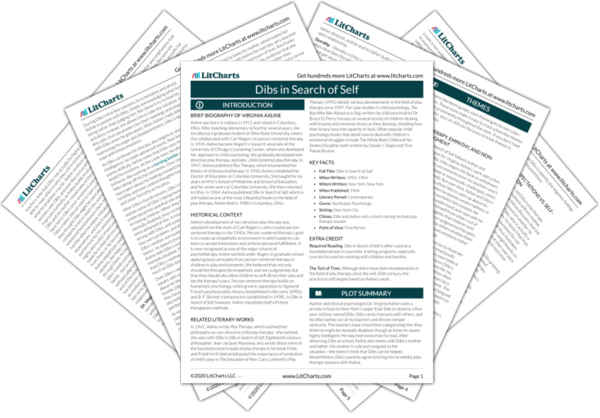Summary
Analysis
The next week, Dibs has the measles, but the following Thursday Dibs recovers enough to have his eighth session. When he arrives, he tells Axline that he liked the get-well card and the flowers she sent him. He says that his father told him the flowers could grow into bushes. Axline is interested in his father showing more engagement with Dibs, and she asks what Dibs said when his father talked to him. Dibs says that he just listened.
This passage suggests that there might be growing trust between Dibs and his father. However, while Dibs is more open to communication as his father engages with him, Dibs still doesn’t fully respond. This is his way of continuing to subvert his father’s expectations and maintain self-determination in their relationship.
Themes
Dibs then asks himself what he wants to do. He replies that he’s not in a hurry, and that he’ll just “be.” He lies down in the sand and pulls out a soldier that another child buried there, then he starts singing the muffin man song, but he replaces the words so that he sings, “Did you know the nothing man? He lives in a dreary grave.” Dibs says that he doesn’t talk to his father much, but he doesn’t know why.
Dibs relishes the ability to just “be,” indicating that he enjoys the escape from parental pressures. Because he is able to go at his own pace during his therapy sessions, he is more expressive of his emotions. He also finds more peace within himself, whereas before he was roiled with constant conflict about facing their expectations. Additionally, Dibs’s new version of the muffin man song indicates his ability to be more expressive about his relationship with his father, because his father is often a negative (or absent) presence in his life.
Themes
Axline wonders if Dibs’s behavior has changed at all in school—his teachers have not reached out to her at all. Meanwhile, Dibs continues to play in the sandbox until he suddenly opens the playroom door and takes the sign from the door. He points to the sign and asks what therapy is, a question that surprises Axline. Axline says that it means a chance to come play and talk in any way Dibs wants to—a time when he can be himself. Dibs worries about hearing someone coming down the hall, and he asks if the room is just for him, and Axline says it’s just for him at this time every week if he wants it that way. Dibs says it’s for him and for Axline as well, and he replaces the sign.
Axline’s definition of therapy emphasizes her non-judgmental approach: that therapy should allow Dibs to maintain autonomy.In addition, Dibs’s reaction to the person coming down the hall illustrates how much trust Dibs has built with Axline in the playroom. However, Dibs is clearly still wary of new situations and people, which means that even though Axline has helped him feel secure within the narrow confines of therapy, he still doesn’t know how to carry that security within himself in other contexts.
Themes
Dibs then tells Axline that he was sad when he had measles because he couldn’t read books. Axline asks what he likes to read, and Dibs says that he has books about everything but that he likes science books best. He repeats that he really liked Axline’s card, which his mother let him keep next to his bed. Axline wonders how Dibs learned to read, write, and draw—according to existing learning theories, he should not have been able to obtain these skills without getting instruction and mastering verbal language first.
Dibs’s reading skills (and other indications of his intelligence) suggest that his parents did have a hand in helping to foster these skills, especially because they provided him with such advanced material. It also hints at how much they have been emphasizing his intellectual capabilities at the expense of his emotional and social skills.
Themes
Get the entire Dibs in Search of Self LitChart as a printable PDF.

Dibs hears the church bells ring and Axline says he has fifteen minutes left in his session. Dibs is very happy, and he exclaims about the beautiful day. He then rearranges the paints and sings about making a farm and building a fence. He puts the animal figures behind the fence and tells the cow to “straighten up” and not to “act like such a stupid idiot.”
Here Dibs starts to hint at some of the ways in which his parents’ expectations have become deeply ingrained in his psyche. His language about the cow is almost certainly parroted from his father, and it becomes clear that his father is often harsh and judgmental towards him and others.
Themes
Dibs hears the bells ring again, and Axline says it’s time for Dibs to go. Dibs tries to pretend that it’s one o’clock and that he doesn’t have to go, but he gradually relents and agrees that he has to leave. He smiles at Axline and says goodbye, putting on his hat and coat. Axline observes that Dibs seems more at ease with his mother and even his father now. She wonders if they’re changing their behavior towards Dibs, or if Dibs is simply relating to them more.
Axline illustrates here that non-judgmental therapy not only benefits Dibs, but also his parents. Because Dibs is able to gain emotional and social skills through therapy, his parents are in turn able to relate to him more openly and lovingly.
Themes












